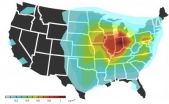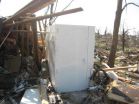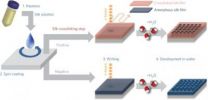(Press-News.org) Ammonia pollution from agricultural sources poses larger health costs than previously estimated, according to NASA-funded research.
Harvard University researchers Fabien Paulot and Daniel Jacob used computer models including a NASA model of chemical reactions in the atmosphere to better represent how ammonia interacts in the atmosphere to form harmful particulate matter. The improved simulation helped the scientists narrow in on the estimated health costs from air pollution associated with food produced for export – a growing sector of agriculture and a source of trade surplus.
"The 'cost' is an economic concept to measure how much people are willing to pay to avoid a risk," Paulot said. "This is used to quantify the cost for society but also to evaluate the benefits of mitigation."
The new research by Paulot and Jacob calculate the health cost associated with the ammonia emissions from agriculture exports to be $36 billion a year – equal to about half of the revenue generated by those same exports – or $100 per kilogram of ammonia. The study was published December 2013 in Environmental Science & Technology.
The new estimate is about double the current estimate by the U.S. Environmental Protection Agency, which suggests a cost of $47 per kilogram of ammonia. The scientists say the new estimate is on the high end of the spectrum, which reflects the need for more research into characterizing the relationship between agricultural ammonia emissions and the formation of the harmful fine particulate matter – a relationship that's not as straightforward as previous estimates assumed.
"The effect of ammonia on fine particulate is complex, and we believe that the models previously used in the United States to price ammonia emissions have not captured this well," Paulot said.
Manure from livestock and fertilizer for crops release ammonia to the atmosphere. In the air, ammonia mixes with other emissions to form microscopic airborne particles, or particulates. The particulates that pose the greatest health risk are those that measure no more than 2.5 micrometers across, or about 1/30 the width of a human hair, which when inhaled can become lodged deep within the lungs. Long-term exposure has been linked to heart and lung diseases and even death. As such, the particles are on the list of six common air pollutants regulated by EPA's National Ambient Air Quality Standards.
An increase in ammonia, however, does not translate to an equal increase in particulates. The relationship depends on meteorology as well as the concentration of other precursors to particulate formation, such as sulfate and nitric acid.
To clarify the effect of ammonia on fine particulates, Paulot and Jacob first modeled the agricultural sources of ammonia emissions utilizing a relatively new ammonia emissions inventory. Next they used the NASA GEOS-Chem model of atmospheric composition to simulate the complex chemistry that converts agricultural emissions – in this case ammonia – into fine particulate matter.
This information was then combined with food export data from the U.S. Department of Agriculture and the United Nations Food and Agriculture Organization, averaged from 2000 to 2009. Results show that U.S. food exports account for 11 percent of the total U.S. emissions of ammonia.
"Our study suggests controls on ammonia emissions from agriculture could help reduce particulate matter and provide significant societal benefits," Paulot said.
The impact, however, is not equal everywhere. Areas downwind of large agricultural regions often set the stage for more mixing of ammonia with man-made emissions from combustion, such as from traffic and power plants. More mixing means the formation of more fine particulate matter. For this reason, the largest health costs are most often carried by the more populated states in the Northeast and Great Lakes region.
INFORMATION:
The research was sponsored by NASA as part of the Air Quality Applied Sciences Team (AQAST) program.
NASA monitors Earth's vital signs from land, air and space with a fleet of satellites and ambitious airborne and ground-based observation campaigns. NASA develops new ways to observe and study Earth's interconnected natural systems with long-term data records and computer analysis tools to better see how our planet is changing. The agency shares this unique knowledge with the global community and works with institutions in the United States and around the world that contribute to understanding and protecting our home planet.
For more information about NASA's Earth science activities in 2014, visit:
http://www.nasa.gov/earthrightnow
Research clarifies health costs of air pollution from agriculture
2014-03-28
ELSE PRESS RELEASES FROM THIS DATE:
NIST issues final Joplin tornado report, begins effort to improve standards and codes
2014-03-28
The National Institute of Standards and Technology (NIST) has released the final report on its technical investigation into the impacts of the May 22, 2011, tornado that struck Joplin, Mo. The final report is strengthened by clarifications and supplemental text suggested by organizations and individuals from across the nation in response to the request for comments on the draft Joplin report, released Nov. 21, 2013.
The revisions did not alter the investigation team's major findings or its 16 recommendations, highlighted by NIST's call for nationally accepted standards ...
Whether they reduce fat or not, obesity programs lower kids' blood pressure
2014-03-28
BUFFALO, N.Y. – One of the serious health consequences of obesity is elevated blood pressure (BP), a particular problem in children because research has found that high BP in children usually follows them into adulthood, carrying with it a wide range of possible negative consequences.
Even modest elevations in the BP of adolescents, according to recent research, can pose cardiovascular problems later in life.
A systematic review and meta-analysis of published studies of the effect of child obesity intervention programs on blood pressure has found that whether such programs ...
Stigmas, once evolutionarily sound, are now bad health strategies
2014-03-28
Stigmatization may have once served to protect early humans from infectious diseases, but that strategy may do more harm than good for modern humans, according to Penn State researchers.
"The things that made stigmas a more functional strategy thousands of years ago rarely exist," said Rachel Smith, associate professor of communication arts and sciences and human development and family studies. "Now, it won't promote positive health behavior and, in many cases, it could actually make the situation worse."
Stigmatizing and ostracizing members stricken with infectious ...
Fabricating nanostructures with silk could make clean rooms green rooms
2014-03-28
MEDFORD/SOMERVILLE, MASS. -- Tufts University engineers have demonstrated that it is possible to generate nanostructures from silk in an environmentally friendly process that uses water as a developing agent and standard fabrication techniques. This approach provides a green alternative to the toxic materials commonly used in nanofabrication while delivering fabrication quality comparable to conventional synthetic polymers. Nanofabrication is at the heart of manufacture of semi-conductors and other electronic and photonic devices.
The paper describing this work, "All ...
Safety and immunogenicity of 2 doses of the HPV-16/18 AS04 adjuvanted vaccine Cervarix
2014-03-28
A recent study in the journal Human Vaccines & Immunotherapeutics, showed that two doses of the HPV-16/18 AS04-adjuvanted vaccine Cervarix (GlaxoSmithKline) are non-inferior to three-doses in the current schedule.
Since high coverage and compliance rates can be difficult to achieve with the current three-dose HPV vaccineregimen, several studies have looked at the possibility of reducing the number of doses. Proof-of-principle that a two-dose schedule can provide sufficient protection against cervical cancer came initially from a study performed in Costa Rica in 2011. ...
Repeated hUCB injections may improve prognosis of children with deadly inherited disorder
2014-03-28
Putnam Valley, NY. (Mar. 28 2014) – New insight has been gained into treating an inherited disorder that creates serious neurological and behavioral disabilities in children and usually leads to death in the teen years.
In a recent study into the effects of human umbilical cord blood mononuclear cells (hUCB MNCs) when they are injected to counter the symptoms and progression of Sanfilippo syndrome type III B (MPS III B), researchers found that repeated injections into laboratory mice modeled with the disorder had clear benefits for the mice receiving multiple injections ...
Rainbow-catching waveguide could revolutionize energy technologies
2014-03-28
BUFFALO, N.Y. – More efficient photovoltaic cells. Improved radar and stealth technology. A new way to recycle waste heat generated by machines into energy.
All may be possible due to breakthrough photonics research at the University at Buffalo.
The work, published March 28 in the journal Scientific Reports, explores the use of a nanoscale microchip component called a "multilayered waveguide taper array" that improves the chip's ability to trap and absorb light.
Unlike current chips, the waveguide tapers (the thimble-shaped structures above) slow and ultimately absorb ...
Gene may predict if further cancer treatments are needed
2014-03-28
DALLAS – March 28, 2014 – UT Southwestern Medical Center researchers are developing a new predictive tool that could help patients with breast cancer and certain lung cancers decide whether follow-up treatments are likely to help.
Dr. Jerry Shay, Vice Chairman and Professor of Cell Biology at UT Southwestern, led a three-year study on the effects of irradiation in a lung cancer-susceptible mouse model. When his team looked at gene expression changes in the mice, then applied them to humans with early stage cancer, the results revealed a breakdown of which patients have ...
Erectile dysfunction can be reversed without medication
2014-03-28
Men suffering from sexual dysfunction can be successful at reversing their problem, by focusing on lifestyle factors and not just relying on medication, according to research at the University of Adelaide.
In a new paper published in the Journal of Sexual Medicine, researchers highlight the incidence of erectile dysfunction and lack of sexual desire among Australian men aged 35-80 years.
Over a five-year period, 31% of the 810 men involved in the study developed some form of erectile dysfunction.
"Sexual relations are not only an important part of people's wellbeing. ...
NUS researchers developed world's first fluorescent sensor to detect date rape drug
2014-03-28
A team of researchers from the National University of Singapore (NUS) has developed the world's first fluorescent sensor to identify the presence of a drug known as GHB that is commonly used to spike beverages. When the sensor is mixed with a sample of a beverage containing GHB, the mixture changes colour in less than 30 seconds, making detection of the drug fast and easy.
This simple mix-and-see discovery, led by Professor Chang Young-Tae of the Department of Chemistry at the NUS Faculty of Science, is a novel scientific breakthrough that contributes towards prevention ...






